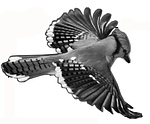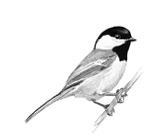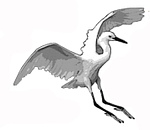FOR THE BIRDS
Each morning, from frosty fall into spring, my husband heads out to our backyard no matter the weather, weather, dressed in robe, slippers and knit hat, to feed his birds. As he sprinkles seeds about, he whistles and within minutes a handful of blue jays appear followed by mourning doves, sparrows and a small army of squirrels.
Throughout the day, chickadees, juncos, cardinals, woodpeckers, grackles and nuthatches that tough it out through the winter join the parade. Robins have now returned and the sounds of songbirds can be heard. Soon others such as orioles, warblers and catbirds could be dropping in. It’s time to clean out birdhouses. Before long many of them will be sporting new families.
We feed the birds black-oil sunflower seed. It’s high in energy and has thin shells. According to the Cornell Lab for Ornithology website, sunflower seeds are the overall favorite of tree-feeding species, while ground-feeding birds such as sparrows and doves that feed on flat surfaces prefer white millet or red milo.
During spring and summer, songbirds eat insects and spiders, but fall through winter, non-migratory songbirds shift their diets to fruits and seeds to survive. Birds such as robins, thrushes and waxwings, where seeds are not a major component of their diet, enjoy fruit such as dried raisins softened by soaking in water as well as fresh fruit. Many backyard birds also enjoy peanuts and seeds from squash and melons. Air-dry seeds first, and then run them through a food processor for smaller birds to eat.
Birds “chew” their food in the muscular part of their stomach. Swallowing small, hard materials such as sand, small pebbles and ground eggshells help with the grinding. Eggshells have the added benefit of being a good source of calcium, something birds need during egg laying. Boil the shells for 10 minutes to sterilize them, and then crush into pieces the size of sunflower seeds.
Birds need water for drinking and bathing. A shallow, easy-to-clean birdbath is best. If you don’t have a birdbath a shallow pan will do. Change the water frequently. In winter, unfrozen water can be as hard for birds to find as food. Immersion-style water heaters are available to keep ice from forming.
This year has been designated The Year of the Bird by The National Audubon Society, National Geographic and the Cornell Lab of Ornithology among others. It marks the Centennial anniversary of the signing of the Migratory Bird Treaty Act, which prohibits the harming of migratory bird species. This important piece of legislation has saved millions of birds and has brought birds like the snowy egret, the sandhilll crane, the trumpeter swan and the bald eagle back from near-extinction.
For the past four decades, the U.S. Fish and Wildlife Service has interpreted the treaty in an expansive light to cover both deliberate and accidental kills, and has penalized companies that don’t work to fix hazardous sites such as oil waste pits, communication towers, transmission lines, gas flares and wind turbines. Because of this, companies have developed low tech solutions such as covering tar pits with netting, installing flashing red lights on communication towers and making power lines more visible.
But this interpretation is now at risk. Recently, Representative Liz Cheney added a last minute addition to a proposed energy bill, which would gut the Migratory Bird Treaty Act by ending any enforcement of bird deaths resulting from the activities of oil companies and other industries. This would result in the deaths of millions of birds a year, which would be a tragedy. Novelist Jonathan Franzen says of birds, “They are our last, best connection to this natural world that is otherwise receding.”




